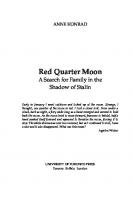A Search for an Electrostatic Analog to the Gravitational Red Shift
223 19 485KB
English Pages 3 Year 1931
Recommend Papers
File loading please wait...
Citation preview
620
PHYSICS: KENNED Y AND THORNDIKE
PROC. N. A. S.
A SEARCH FOR AN ELECTROSTATIC ANALOG TO TIE GRAVITATIONAL RED SHIFT By Roy J. KENNEDY AND EDWARD M. THORNDIKE NORMAN BRIDGE LABORATORY OF PHYSICS, CALIFORNIA INSTITUTE OF TECHNOLOGY
Communicated October 9, 1931
A well-known consequence of the general theory of relativity is that the observed frequencies of spectral lines in a source of light depend on the difference of gravitational potential between the locations of the source and the observer. The possibility of a similar dependence of frequency on electrostatic potential has led the writers to perform the experiment described in this paper. An effect of the sort would evidently require to be taken into account in the formulation of a satisfactory unified field theory, and by an extension of the theory of Zwicky (Proc. Nat. Acad. Sci., 1929, Vol. 15), would be involved in the question of the red shift observed in distant nebulae. We have been the more inclined to undertake the exacting and delicate work because it has required only a modification of apparatus devised for another purpose. The experiment consists essentially in comparing the frequency of a spectral line in a suitable source at zero potential with that of the same source under identical conditions except that its electrostatic potential is raised or lowered, the observing apparatus being at zero potential in both cases. Apparatus.-The source was an electrodeless discharge in mercury vapor. The discharge tube contained a pool of mercury outside of the arc, and was surrounded by boiling carbon tetrachloride and connected 'to vacuum pumps through a heated capillary tube. By this means the tube was kept at a low constant temperature so as to yield sharp lines, land since the pressure of mercury vapor was below the vapor pressure corresponding to the existing temperature, there was no Doppler effect in one direction such as might have occurred if there were a net transport of atoms due to evaporation and subsequent condensation elsewhere of the mercury. An asymmetrical Doppler effect corresponding to a velocity of only a few centimeters per second would have been objectionable. By way of eliminating Stark effects, the source and accessory pumps and oscillator tubes were mounted in a heavy copper enclosure of which the necessary ventilating openings were covered with conducting screening and the window with a glass cell containing a transparent electrolyte. Possible effects on the source of any small electrostatic force resulting from imperfect shielding could be eliminated from the final result by simply comparing frequencies obtained with shielding positive with those for equal negative potential. This is so since reversing sign of potential
VOL. 17, 1931
PHYSICS: KENNEDYAND THORNDIKE
621
merely reverses direction of stray field, and this is equivalent to reversing direction from which source is viewed. Current was supplied to oscillator and pumps at constant voltage by suitable insulating transformer. The mercury in the discharge tube was connected to the shielding, which could be kept at a steady potential of about 50,000 volts above or below ground by means of a transformer and a rectifier. The light was received in an interferometer of the Michelson type built almost completely of fused quartz and contained in a vacuum chamber in a water-bath at temperature constant to within 10-3 degrees C. The vacuum is necessary in order to keep optical path-difference constant. The interferometer is compensated for temperature so accurately that the permitted variation produces a variation in path of only 10-5 wavelengths. The fixed difference of path is some 582,000 wave-lengths of the line 5461 which was used. Sections of the interference pattern (a system of concentric rings) were automatically photographed in such a way that exposures taken with source at high potential were interleaved with those for zero potential. By this procedure errors due to differences among individual photographic plates were minimized. The interferometer was at zero potential throughout the experiment. A simple comparator was employed in which the interference rings to be measured are compared directly with those on a nearly identical reference plate. With this device each exposure can be measured with a probable error corresponding to a variation in path-difference of about 10-3 wave-lengths. That is, the probable error for each exposure corresponds to a variation of frequency of one part in 1000 X 582,000 or 1.7 in 109. Data and Results.-Eighteen pairs of exposures were taken in the comparison of frequencies for positive and for ground potential, and sixteen pairs for negative and ground potential. The first series, which was the more carefully measured, indicated a change of frequency of only 1.1 0.8 parts in 1014 per volt; the second a change of 3.1 1.6 parts in 1014 volt. Both per changes were in the same direction. These values were so nearly the same as their probable errors as to indicate clearly a null effect. Even if they were regarded as real, the fact that both are of the same sign shows that they cannot be due to a simple linear potential relation. Summary.-An attempt is made to determine whether the frequency of light is affected by a difference in electrostatic potential between the source of light and the measuring apparatus. The source is an electrodeless discharge in mercury vapor which can be kept at a potential about 50,000 volts above or below ground. The apparatus for measuring the change in frequency is a quartz interferometer of the Michelson type with a fixed path-difference of 31.8 centimeters, in an evacuated case and kept =
622
PHYSICS: KENNEDY AND THORNDIKE
PROC. N. A. S.
at constant temperature. With this and a special comparator it is possible to detect an extremely sknall change in frequency. No effect due to potential was found. We are greatly indebted to Dr. Jesse DuMond and Dr. Archer Hoyt for assistance and advice in connection with the high-voltage apparatus.










